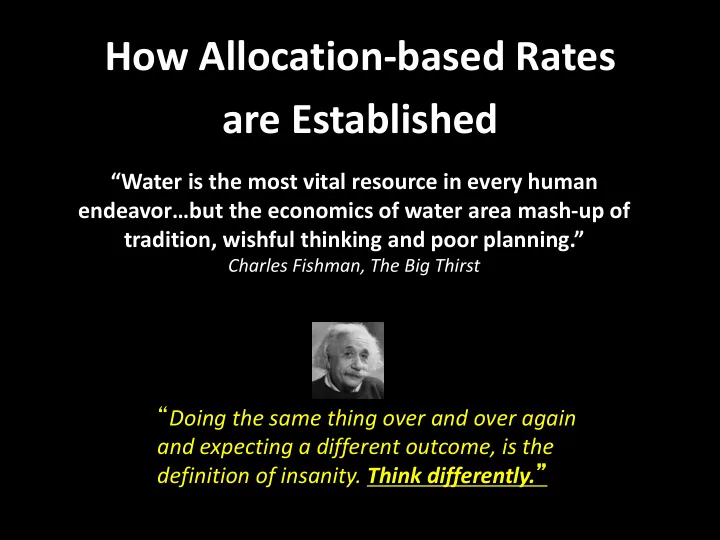

How Allocation-based Rates are Established “Water is the most vital resource in every human endeavor…but the economics of water area mash -up of tradition, wishful thinking and poor planning.” Charles Fishman, The Big Thirst “ Doing the same thing over and over again and expecting a different outcome, is the definition of insanity. Think differently. ”
Successful Rates = Asking the Right Questions: 1. Maintain revenue stability regardless of water sales “Sustainable” Rate Structure 2. Create a “conservation ethic” (efficiency by all customers all the time) 3. Be fair and equitable to customers 4. Get board re-elected 1. Cost Recovery 2. Allocations/Incentives Variable Charge Fixed Variable Charge/ Charge/ System Cost Water Cost Fixed Charge/ Variable Charge/ System Cost Water Cost
How Allocation-based Rates Align w/ State Legislation, User Needs, Science & Logic (# Residents) (55 gpcd) + (ET) (SF) (.80) = Household Allocation (Reality + State Standard) + (Science + Reality + State Standard + Logic) = Win/Win
(# Residents) (55 gpcd) + (ET) (SF) (.80) = Household Allocation Tiered Charges only for over allocation use
Typical Rate Structure Process w/ Added Steps for Sophistication (# Residents) (55 gpcd) + (ET) (SF) (.80) = Household Allocation Process: 1. Board/staff workshop 2. Board direction to staff 3. Staff involvement 4. Cost of service study/rate study SAWPA Grant 5. Development of landscape square footage data 6. Development of local ET 7. Billing system review/upgrade 8. Policy review 9. Board review 10.Stakeholder outreach 11. Testing the “system” 12. Public Hearing/Prop 218
Allocation-based Rates Make Sense to Users (# Residents) (55 gpd) + (ET) (SF) (.80) = Allocation 3 Las Virgenes MWD Board Members Use Allocation 20% Reduction
What is the Impact of 85 100 % 85% 85% Allocation-based Rates? 80 • Less risk of “Fixed” revenue loss 60 (regardless of weather, water use, I understand 40 drought, economy) the IRWD’s rate structure • Significant landscape use 20 reduction 0 • New funding mechanism for The water I understand the IRWD’s water allocation rate structure efficiency programs allocation process process is fair • is fair High Customer response (80%+) • Reduced urban water runoff Residential GPCD
A Great Story…? WBR Implementations: • IRWD (1991) • “People now pay attention to • Highlands Ranch, Co. (2003) leaks and water waste.” PWD • Castle Rock, Co. (2004) • Agency cost recovery is right • Boulder, Co. (2007) where we estimated even • Palmdale WD, (2008) with significant water • Coachella Valley WD (2008) savings.” RCWD • Eastern Municipal WD, (2009) • “85% of our users meet the • City of Corona (2009) water efficiency standards.” • Rancho California WD (2010) MNWD • Elsinore Valley MWD (2010) • “We have 90%+ Customer • El Toro WD (2010) Satisfaction.” IRWD • Monte Vista WD (2010) • “ We had a payback for the • Moulton Niguel WD (2011) new rate structure • Western Municipal WD (2011 ) implementation within 6 • East Valley WD (2015) months . ” WMWD • Las Virgenes MWD (2016)
“Change” itself is “Hard” Change is Happening… • State Legislation • Climate Customers View of Agencies: • Public Perception • “70 % of the public has a very “You asked us to save and poor understanding of water systems and services” (AWWA, then you raise our rates…” SOTWI, 2014) Or, • “Effectively communicating… “ Your rates are unfair for my the industry has struggled…” family and business …” (AWWA SOTWI, 2014)
Is There a Cost of NOT Changing? Special District of 20k Accounts City of 300k Accounts • Lost $25 million between 2008-2012) • Used $5 million out of Reserves to balance the budget since 2010 (Customers unhappy w/ fixed tiers) (Customers unhappy w/ fixed tiers) Why? Source: 2006 City Rate Study • 65% of costs are fixed • 16% of fixed costs recovered on fixed charge • 84% of fixed costs imbedded in tiers (variable charge) • Customers used less water, partly due Spread more Fixed costs across 3 Tiers creating to economy and drought Higher priced water (tiers)
“Water is Free, why do I have to pay for it all?” $.003 / per gallon $2/day / household “I just had the most amazing phone call. This customer called quite upset, armed with plenty of misconceptions about the water industry that he was ready to attack me with. I was able to counter all his points in a kind but brutally honest way. It was awesome! Wish more people would call with hard questions about water and the industry.” (5/2/14) Gregory Bucy, Customer Service Rep 1, WMWD 11
Allocation- based Rate Structure… • Solve for the right questions • Equity does take more data, more time, more work • Model any scenario • Changes the relationship between the customer and water, and the agency and constituents “Think differently. ”
Are Tiered Water Budget Rates Legal? “We see nothing in Article XIII, section 6, subdivision (b) (3) of the California Constitution that is incompatible with water agencies passing on the true cost of water to those consumers whose extra use of water forces water agencies to incur higher costs to supply that extra water.” Court of Appeal – 4 th District, April 20, 2015 Designed to meet the Designed to meet Prop 218 “Cost of Service” • • Proportional to the parcel Financial study • Model scenarios of cost • Nexus between the rate per recovery tier and the water source • Settle on the design that Predictable Failure of cost achieves the various agency Rate Desi gn • Utilize State efficiency goals with the least financial risk to the agency guidelines
What Did it Look Like 4/10/14 5/09/14 1255 1337 82 CCF USAGE – INDOOR 16 1.48 $23.68 USAGE - OUTDOOR 23 2.64 $20.72 USAGE - INEFFICIENT 20 4.28 $85.60 USAGE - EXCESSIVE 19 8.56 $162.64 USAGE - ABUSIVE (UNSUSTAINABLE) 4 11.10 $44.40 WATER SERVICE CHARGE $23.90 SEWER SERVICE CHARGE $16.90 YOUR ALLOCATION FOR THIS BILL 39 CCF BILL CALCULATION BASED ON .12 ACRES $377.84
Recommend
More recommend